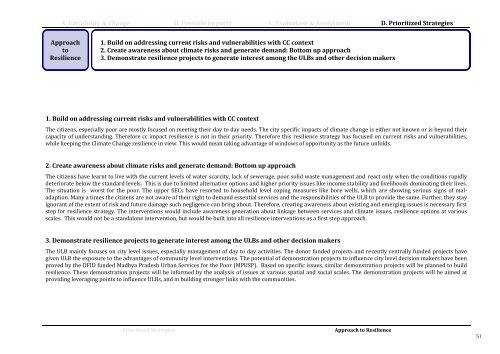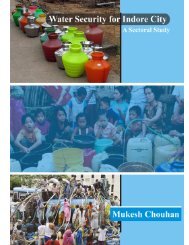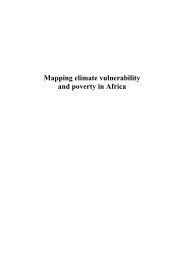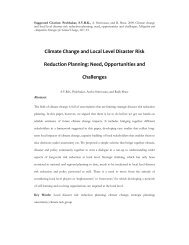Indore City Resilience Strategy - ImagineIndore.org
Indore City Resilience Strategy - ImagineIndore.org
Indore City Resilience Strategy - ImagineIndore.org
Create successful ePaper yourself
Turn your PDF publications into a flip-book with our unique Google optimized e-Paper software.
A. Variability & Change B. Possible Impacts C. Evaluation & Assessment D. Prioritized Strategies<br />
Approach<br />
to<br />
<strong>Resilience</strong><br />
1. Build on addressing current risks and vulnerabilities with CC context<br />
2. Create awareness about climate risks and generate demand: Bottom up approach<br />
3. Demonstrate resilience projects to generate interest among the ULBs and other decision makers<br />
1. Build on addressing current risks and vulnerabilities with CC context<br />
The citizens, especially poor are mostly focused on meeting their day to day needs. The city specific impacts of climate change is either not known or is beyond their<br />
capacity of understanding. Therefore cc impact resilience is not in their priority. Therefore this resilience strategy has focused on current risks and vulnerabilities,<br />
while keeping the Climate Change resilience in view. This would mean taking advantage of windows of opportunity as the future unfolds.<br />
2. Create awareness about climate risks and generate demand: Bottom up approach<br />
The citizens have learnt to live with the current levels of water scarcity, lack of sewerage, poor solid waste management and react only when the conditions rapidly<br />
deteriorate below the standard levels. This is due to limited alternative options and higher priority issues like income stability and livelihoods dominating their lives.<br />
The situation is worst for the poor. The upper SECs have resorted to household level coping measures like bore wells, which are showing serious signs of maladaption.<br />
Many a times the citizens are not aware of their right to demand essential services and the responsibilities of the ULB to provide the same. Further, they stay<br />
ignorant of the extent of risk and future damage such negligence can bring about. Therefore, creating awareness about existing and emerging issues is necessary first<br />
step for resilience strategy. The interventions would include awareness generation about linkage between services and climate issues, resilience options at various<br />
scales. This would not be a standalone intervention, but would be built into all resilience interventions as a first step approach.<br />
3. Demonstrate resilience projects to generate interest among the ULBs and other decision makers<br />
The ULB mainly focuses on city level issues, especially management of day to day activities. The donor funded projects and recently centrally funded projects have<br />
given ULB the exposure to the advantages of community level interventions. The potential of demonstration projects to influence city level decision makers have been<br />
proved by the DFID funded Madhya Pradesh Urban Services for the Poor (MPUSP). Based on specific issues, similar demonstration projects will be planned to build<br />
resilience. These demonstration projects will be informed by the analysis of issues at various spatial and social scales. The demonstration projects will be aimed at<br />
providing leveraging points to influence ULBs, and in building stronger links with the communities.<br />
Prioritized Strategies<br />
Approach to <strong>Resilience</strong><br />
51









